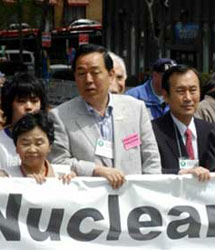 |
 |
 |
 News from Around the Americas | May 2005 News from Around the Americas | May 2005  
Thousands Protest on Eve of a UN Nuclear Conference
 Kirk Semple - NYTimes Kirk Semple - NYTimes


| | Mayors Itcho Ito from Nagasaki, center, and Tadatoshi Akiba from Hiroshima, second right, along with survivors march in New York City, to commemorate the dropping of atomic bombs on Japan 60 years ago and to show support for the anti-nuclear proliferation act, soon to be reviewed by the UN. (Photo: AP) |
In a merger of the nuclear disarmament and antiwar movements, several thousand protesters, including a group of survivors of the atomic bomb attacks on Hiroshima and Nagasaki, marched through Midtown yesterday and rallied in Central Park to call for the end of nuclear proliferation and the withdrawal of United States troops from Iraq.

The impetus for the event was a conference at the United Nations, scheduled to begin today, to review the flaws in the Nuclear Nonproliferation Treaty. Organizers said they hoped the rally would help resuscitate the faded antinuclear movement.

"We feel it is important to continue our focus on ending the war in Iraq and strengthening our movement by making the connection to nuclear disarmament," said Leslie Cagan, national coordinator of United for Peace and Justice, which helped to organize the march with Abolition Now!, a coalition of nuclear disarmament groups. "Given that the Nonproliferation Treaty conference is going on, we thought it was the right time to make that connection and re-energize opposition to nuclear weapons."

While the turnout was a fraction of that of antinuclear rallies in the early 1980's, the event drew a diverse array of participants from around the country and the world, most notably a contingent of hundreds from Japan, including the mayors of Hiroshima and Nagasaki and about 35 survivors of the atomic bomb attacks.

Among them was Sunao Tsuboi, 80, who was a university student in Hiroshima on Aug. 6, 1945, when that city was destroyed by the first atomic bomb attack. He described how his entire body was burned and said that the aftermath of the bombing was "a living hell on earth." The radiation left him with numerous illnesses, Mr. Tsuboi said, including cancer.

"I'm here for the abolition of nuclear weapons," he said in an interview through an interpreter. "And I want all the nations to keep the promise of the Nonproliferation Treaty."

Yuko Nakamura, 73, who wore a necklace of colorful origami cranes, said she was working in a factory about 13 miles from the blast and suffered the effects of radiation.

"Don't let the children go through that nuclear suffering," she said. "This is not the children's fault. It's the adults' fault. I really care for the future of children."

With the end of the cold war, organizers said yesterday, many people believed that the nuclear threat had ended, too. But, they said, most of the world's major powers still maintain nuclear arsenals, and other nations may be getting into the act.

The United States says that Iran and North Korea have exploited loopholes in the Nonproliferation Treaty to pursue nuclear weapons programs that threaten world stability.

"The public has been complacent," said Ms. Cagan, who called for all nuclear nations to adhere to the treaty. "There really are nuclear weapons in the world. They really are dangerous."

Tadatoshi Akiba, the mayor of Hiroshima, told the protesters gathered at the Heckscher ball fields in Central Park to listen to live music and a long slate of speakers: "There is nothing normal, natural or necessary about nuclear weapons. They're a deadly cancer on the planet that need to be removed."

Still, as current as the nuclear threat may be, the march yesterday had an anachronistic quality about it, with ardent antiwar chants and dove-festooned peace banners that have changed little in decades.

The somberness was at times leavened by carnivalesque episodes that included a Japanese drum-and-cymbal ensemble that periodically broke into a high-stepping jig; bits of political theater involving pranksters wearing President Bush masks; a marching band featuring a banjo and led by a majorette with green hair and lug-sole boots; and a bagpiper playing an endless loop of Bob Dylan's "Blowin' in the Wind."

"It's reminiscent of the 60's, without the nudity," commented Lionel Goldbart, 70, a poet and former civil rights activist visiting from his home in Miami Beach. He was distributing fliers for an exhibit of peace sculptures at the United Nations by a self-described "atomic artist."

Mr. Goldbart said he was particularly struck by the words of the survivors of the atomic bomb attacks.

"There were so many Japanese people," he said. "It really made me feel bad because we dropped those bombs on them."

Colin Moynihan contributed reporting for this article. | 
 | |
 |



